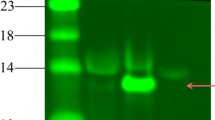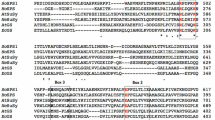Abstract
Ginkgo seed is an important Chinese medicine and food resource in China, but the toxicity of ginkgo acid in it limits its application. Previous studies have found that salicylic acid decarboxylase (Sdc) has a decarboxylation degradation effect on ginkgo acid. In order to improve the decarboxylation ability of Sdc to Ginkgo acid, 11 residues of the Sdc around the substrate (salicylic acid) were determined as mutation targets according to the analysis of crystal structure of Sdc (PDB ID:6JQX), from Trichosporon moniliiforme WU-0401, and a total of 30 single point mutant enzymes and one compound mutant enzyme were obtained. With Ginkgo acid C15:1 as the substrate, it was found from activity assay that Sdc-Y64T and Sdc-P191A had higher decarboxylation activity, which increased by 105.18% and 116.74% compared with that of wild type Sdc, respectively. The optimal pH for Sdc Y64T and Sdc-P191A to decarboxylate Ginkgo acid C15:1 was 5.5, which is the same as the wild type Sdc. The optimal temperature of Sdc-P191A was 50 °C, which was consistent with that of the wild type Sdc, but the optimal temperature of the mutant Sdc-Y64T was 40 °C, which was 10 °C lower than that of wild type Sdc.









Similar content being viewed by others
References
Small E, Catling P (2003) Blossoming treasures of biodiversity 7. Ginkgo biloba—brain food from a living fossil. Biodiversity 4:29–31
Houghton PJ (1995) The role of plants in traditional medicine and current therapy. J Altern Complement Med 1:131–143
Wang H-Y, Zhang Y-Q (2019) The main active constituents and detoxification process of Ginkgo biloba seeds and their potential use in functional health foods. J Food Compos Anal 83:103247
Pang Z, Pan F, He S (1996) Ginkgo biloba L. history, current status, and future prospects. J Altern Complement Med 2:359–363
Zou M, Cao J, Zhang W, Tang C, Cao F, Su E (2021) Improvement of quality of Ginkgo biloba seeds powder by solid-state fermentation with Eurotium cristatum for developing high-value ginkgo seeds products. J Bioresour Bioprod 7(2):135–144
Lu Q, Li R, Yang Y, Zhang Y, Zhao Q, Li J (2022) Ingredients with anti-inflammatory effect from medicine food homology plants. Food Chem 368:130610
Boateng ID (2022) A critical review of current technologies used to reduce ginkgotoxin, ginkgotoxin-5’-glucoside, ginkgolic acid, allergic glycoprotein, and cyanide in Ginkgo biloba L. seed. Food Chem 382:132408
Amoussa AMO, Zhang L, Lagnika C, Riaz A, Zhang L, Liu X, Beta T (2021) Effects of preheating and drying methods on pyridoxine, phenolic compounds, ginkgolic acids, and antioxidant capacity of Ginkgo biloba nuts. J Food Sci 86:4197–4208
Del Tredici P (2000) The evolution, ecology, and cultivation of Ginkgo biloba. Ginkgo biloba 7:23
Mei N, Guo X, Ren Z, Kobayashi D, Wada K, Guo L (2017) Review of Ginkgo biloba-induced toxicity, from experimental studies to human case reports. J Environ Sci Health Part C 35:1–28
Azuma F, Nokura K, Kako T, Kobayashi D, Yoshimura T, Wada K (2020) An adult case of generalized convulsions caused by the ingestion of Ginkgo biloba seeds with alcohol. Internal Med 4196–4119
Fan G-J, Wang X, Wu C-E, Pan H-M, Yang J-T, Li T-T, Tang Z-X, Cao F-L (2017) Effect of heating on the content and composition of ginkgolic acids in ginkgo seeds. Qual Assur Saf Crops Foods 9:195–199
Borenstein R, Hanson BA, Markosyan RM, Gallo ES, Narasipura SD, Bhutta M, Shechter O, Lurain NS, Cohen FS, Al-Harthi L, Nicholson DA (2020) Ginkgolic acid inhibits fusion of enveloped viruses. Sci Rep 10:4746–4746
Liang C, Fengchang L (2004) Studies on long-chain phenolic acids from exopleura of Ginkgo biloba. Prog Pharm Sci 28:209–213
Jiang L, Si Z-H, Li M-H, Zhao H, Fu Y-H, Xing Y-X, Hong W, Ruan L-Y, Li P-M, Wang J-S (2017) 1H NMR-based metabolomics study of liver damage induced by ginkgolic acid (15: 1) in mice. J Pharm Biomed Anal 136:44–54
Dong Q, Cao J, Wu R, Shi T, Zhang W, Cao F, Wang G, Su E (2021) Efficient removal of ginkgolic acids from Ginkgo biloba leaves crude extract by using hydrophobic deep eutectic solvents. Ind Crops Prod 166:113462
Choi YH, Verpoorte R (2019) Green solvents for the extraction of bioactive compounds from natural products using ionic liquids and deep eutectic solvents. Curr Opin Food Sci 26:87–93
Li Q, Sun W, Jiang Y, Cao F, Wang G, Zhao L (2017) Extraction and biodegradation of ginkgolic acids from Ginkgo biloba sarcotestae. Front Agric Sci Eng 4:465–472
Chen HY, Cheng KC, Hsu RJ, Hsieh CW, Wang HT, Ting Y (2020) Enzymatic degradation of ginkgolic acid by laccase immobilized on novel electrospun nanofiber mat. J Sci Food Agric 100:2705–2712
Hu Y, Hua Q, Sun G, Shi K, Zhang H, Zhao K, Jia S, Dai Y, Wu Q (2018) The catalytic activity for ginkgolic acid biodegradation, homology modeling and molecular dynamic simulation of salicylic acid decarboxylase. Comput Biol Chem 75:82–90
Gao X, Wu M, Zhang W, Li C, Guo R-T, Dai Y, Liu W, Mao S, Lu F, Qin H-M (2021) Structural basis of salicylic acid decarboxylase reveals a unique substrate recognition mode and access channel. J Agric Food Chem 69:11616–11625
Dominy CN, Andrews DW (2003) Site-directed mutagenesis by inverse PCR, E. coli plasmid vectors. Springer, New York, pp 209–223
Wibowo S, Widyarti S, Sabarudin A, Soeatmadji DW, Sumitro SB (2019) The role of astaxanthin compared with metformin in preventing glycated human serum albumin from possible unfolding: a molecular dynamic study. Asian J Pharm Clin Res 12:276–282
Ozalp L, Küçükgüzel İ, Ogan A (2022) In silico discovery of potential azole-containing mPGES-1 inhibitors by virtual screening, pharmacophore modeling and molecular dynamics simulations. Struct Chem 33(4):1157–75
Danovaro R, Bongiorni L, Corinaldesi C, Giovannelli D, Damiani E, Astolfi P, Greci L, Pusceddu A (2008) Sunscreens cause coral bleaching by promoting viral infections. Environ Health Perspect 116:441–447
Thornton B, Basu C (2011) Real-time PCR (qPCR) primer design using free online software. Biochem Mol Biol Educ 39:145–154
Zhai Z, Chen X, Wang J (2008) Primer design with primer premier 5.0. Northwest Med Educ 16:695–698
Qi WW, Vannelli T, Breinig S, Ben-Bassat A, Gatenby AA, Haynie SL, Sariaslani FS (2007) Functional expression of prokaryotic and eukaryotic genes in Escherichia coli for conversion of glucose to p-hydroxystyrene. Metab Eng 9:268–276
Taylor SC, Posch A (2014) The design of a quantitative western blot experiment. BioMed Res Int. https://doi.org/10.1155/2014/361590
Wilson ID, Plumb R, Granger J, Major H, Williams R, Lenz EM (2005) HPLC-MS-based methods for the study of metabonomics. J Chromatogr B 817:67–76
Systèmes D (2016) BIOVIA, discovery studio modeling environment. Dassault Systèmes Biovia San Diego
Tandogan B, Sengezer C, Ulusu N (2011) In vitro effects of imatinib on glucose-6-phosphate dehydrogenase and glutathione reductase. Folia Biol (Praha) 57:57–64
V(2017) Origin OriginLab Corporation, Origin (Pro), Version Northampton
Wang W (2015) The molecular detection of Corynespora Cassiicola on cucumber by PCR assay using DNAman software and NCBI. In: International Conference on Computer and Computing Technologies in Agriculture. Springer, New York, pp 248–258
Cheng XT (2020) Research on crystal structure and molecular directed evolution of salicylic acid decarboxylase. TUST(Tianjin University of Science and Technology).
Wang Z, Sun H, Yao X, Li D, Xu L, Li Y, Tian S, Hou T (2016) Comprehensive evaluation of ten docking programs on a diverse set of protein–ligand complexes: the prediction accuracy of sampling power and scoring power. Phys Chem Chem Phys 18:12964–12975
Luger D, Poli G, Wieder M, Stadler M, Ke S, Ernst M, Hohaus A, Linder T, Seidel T, Langer T (2015) Identification of the putative binding pocket of valerenic acid on GABAA receptors using docking studies and site-directed mutagenesis. Br J Pharmacol 172:5403–5413
Roggentin T, Kleineidam RG, Schauer R, Roggentin P (1992) Effects of site-specific mutations on the enzymatic properties of a sialidase from Clostridium perfringens. Glycoconjugate J 9(5):235–40
Torpenholt S, De Maria L, Olsson MHM, Christensen LH, Skjøt M, Westh P, Jensen JH, Lo Leggio L (2015) Effect of mutations on the thermostability of Aspergillus aculeatus β-1,4-galactanase. Comput Struct Biotechnol J 13:256–264
Kirimura K, Gunji H, Wakayama R, Hattori T, Ishii Y (2010) Enzymatic Kolbe-Schmitt reaction to form salicylic acid from phenol: enzymatic characterization and gene identification of a novel enzyme, Trichosporon moniliiforme salicylic acid decarboxylase. Biochem Biophys Res Commun 394:279–284
Acknowledgements
We would like to appreciate Mrs. Ao He and Mr. Mian Wu, the postgraduate students of our school, for their valuable help in the experiment of this paper.
Funding
This work was supported by Natural Science Foundation of Tianjin (Grant numbers 19JCZDJC34800) and Shandong Provincial Natural Science Foundation (Project No. ZR2019MC066).
Author information
Authors and Affiliations
Corresponding author
Ethics declarations
Competing interests
No competing interests declared.
Additional information
Publisher's Note
Springer Nature remains neutral with regard to jurisdictional claims in published maps and institutional affiliations.
Supplementary Information
Below is the link to the electronic supplementary material.
Rights and permissions
Springer Nature or its licensor (e.g. a society or other partner) holds exclusive rights to this article under a publishing agreement with the author(s) or other rightsholder(s); author self-archiving of the accepted manuscript version of this article is solely governed by the terms of such publishing agreement and applicable law.
About this article
Cite this article
Song, Y., Hu, Y., Li, J. et al. Site-Directed Mutation of Salicylate Decarboxylase Gene and Mechanism of Ginkgo Acid Decarboxylation. Protein J 42, 1–13 (2023). https://doi.org/10.1007/s10930-022-10086-1
Accepted:
Published:
Issue Date:
DOI: https://doi.org/10.1007/s10930-022-10086-1




